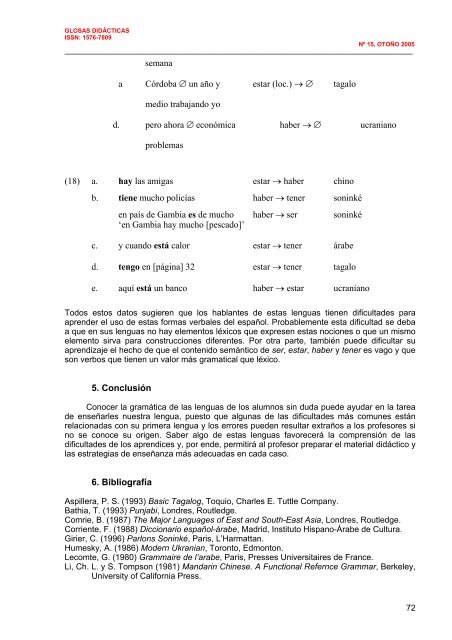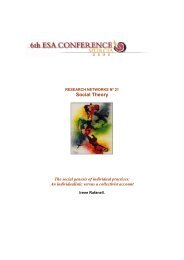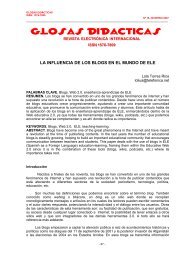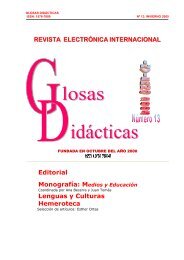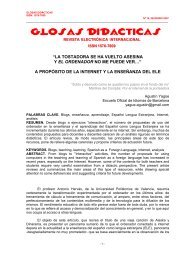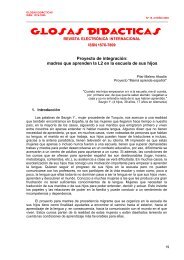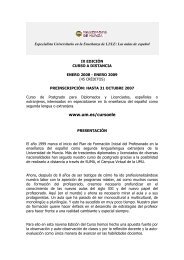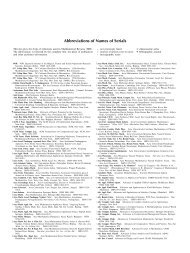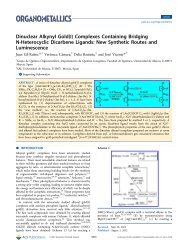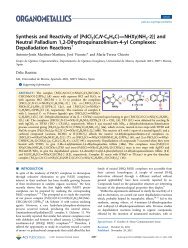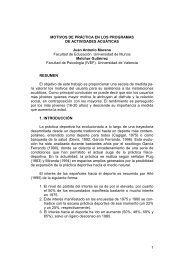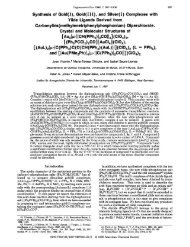Variación gramatical y segundas lenguas. El uso de ser, estar ...
Variación gramatical y segundas lenguas. El uso de ser, estar ...
Variación gramatical y segundas lenguas. El uso de ser, estar ...
You also want an ePaper? Increase the reach of your titles
YUMPU automatically turns print PDFs into web optimized ePapers that Google loves.
GLOSAS DIDÁCTICAS<br />
ISSN: 1576-7809<br />
Nº 15, OTOÑO 2005<br />
_______________________________________________________________________________________________________<br />
semana<br />
a Córdoba ∅ un año y <strong>estar</strong> (loc.) → ∅ tagalo<br />
medio trabajando yo<br />
d. pero ahora ∅ económica haber → ∅ ucraniano<br />
problemas<br />
(18) a. hay las amigas <strong>estar</strong> → haber chino<br />
b. tiene mucho policías haber → tener soninké<br />
en país <strong>de</strong> Gambia es <strong>de</strong> mucho haber → <strong>ser</strong> soninké<br />
‘en Gambia hay mucho [pescado]’<br />
c. y cuando está calor <strong>estar</strong> → tener árabe<br />
d. tengo en [página] 32 <strong>estar</strong> → tener tagalo<br />
e. aquí está un banco haber → <strong>estar</strong> ucraniano<br />
Todos estos datos sugieren que los hablantes <strong>de</strong> estas <strong>lenguas</strong> tienen dificulta<strong>de</strong>s para<br />
apren<strong>de</strong>r el <strong>uso</strong> <strong>de</strong> estas formas verbales <strong>de</strong>l español. Probablemente esta dificultad se <strong>de</strong>ba<br />
a que en sus <strong>lenguas</strong> no hay elementos léxicos que expresen estas nociones o que un mismo<br />
elemento sirva para construcciones diferentes. Por otra parte, también pue<strong>de</strong> dificultar su<br />
aprendizaje el hecho <strong>de</strong> que el contenido semántico <strong>de</strong> <strong>ser</strong>, <strong>estar</strong>, haber y tener es vago y que<br />
son verbos que tienen un valor más <strong>gramatical</strong> que léxico.<br />
5. Conclusión<br />
Conocer la gramática <strong>de</strong> las <strong>lenguas</strong> <strong>de</strong> los alumnos sin duda pue<strong>de</strong> ayudar en la tarea<br />
<strong>de</strong> enseñarles nuestra lengua, puesto que algunas <strong>de</strong> las dificulta<strong>de</strong>s más comunes están<br />
relacionadas con su primera lengua y los errores pue<strong>de</strong>n resultar extraños a los profesores si<br />
no se conoce su origen. Saber algo <strong>de</strong> estas <strong>lenguas</strong> favorecerá la comprensión <strong>de</strong> las<br />
dificulta<strong>de</strong>s <strong>de</strong> los aprendices y, por en<strong>de</strong>, permitirá al profesor preparar el material didáctico y<br />
las estrategias <strong>de</strong> enseñanza más a<strong>de</strong>cuadas en cada caso.<br />
6. Bibliografía<br />
Aspillera, P. S. (1993) Basic Tagalog, Toquio, Charles E. Tuttle Company.<br />
Bathia, T. (1993) Punjabi, Londres, Routledge.<br />
Comrie, B. (1987) The Major Languages of East and South-East Asia, Londres, Routledge.<br />
Corriente, F. (1988) Diccionario español-árabe, Madrid, Instituto Hispano-Árabe <strong>de</strong> Cultura.<br />
Girier, C. (1996) Parlons Soninké, Paris, L’Harmattan.<br />
Humesky, A. (1986) Mo<strong>de</strong>rn Ukranian, Toronto, Edmonton.<br />
Lecomte, G. (1980) Grammaire <strong>de</strong> l’arabe, Paris, Presses Universitaires <strong>de</strong> France.<br />
Li, Ch. L. y S. Tompson (1981) Mandarin Chinese. A Functional Refernce Grammar, Berkeley,<br />
University of California Press.<br />
72


